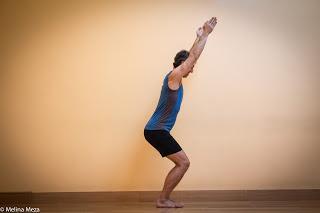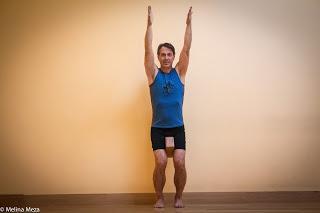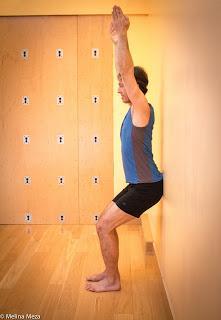
Because Powerful pose strengthens the muscles in your legs, it is one of most helpful poses for maintaining your ability to move from sitting to standing with ease as well as for improving your balance. Additionally, Powerful pose strengthens some arm and upper back muscles, while also stretching your chest and the fronts of your arms. The three variations described below make this pose accessible to almost anyone.
Baxter prescribes this for:
- improving knee strength and healthy knee alignment
- recovering leg strength lost due to illness
- getting in shape for intense physical activity, such as skiing and hiking
- improving balance for those who can’t yet balance one foot or building leg strength to maintain balance
- improving shoulder mobility
Cautions: Those with knee arthritis or pain in the knee area should avoid deeply bending the knees, only going as far as is comfortable. Those with lower back problems/pain should keep their spine more upright. Those with shoulder problems/pain should keep their arms lower than the full pose.
1. Classic Version

Standing Mountain pose, place the block about half way between your knees and your pelvis. Most people can have the block on its narrowest width, but some may need to have it on its middle width. Then squeeze the block firmly with your inner thigh muscles and adjust your feet so they are in line with center of your hip joints and close to parallel.Continuing to squeeze the block, enter the pose by bending your knees and raising your arms as in the classic version. Once in the pose, work your legs and arms as in the classic version. To come out of the pose, continue to squeeze the block as you straighten your legs and release your arms as in the classic pose. Once in Mountain pose, you can remove the block.3. Hips on the Wall
Start in Mountain pose with your hands on the hips. Then, on an exhalation, enter the pose by bending your knees and tipping your torso forward, as in the classic version. Keeping your spine in a neutral position, firm your leg muscles and release your shoulder blades down your back, away from your ears.
To come out of the pose, on an inhalation, straighten your legs. On your exhalation, relax your arms to your sides, returning to Mountain pose.
Subscribe to Yoga for Healthy Aging by Email ° Follow Yoga for Healthy Aging on Facebook ° Join this site with Google Friend Connect
